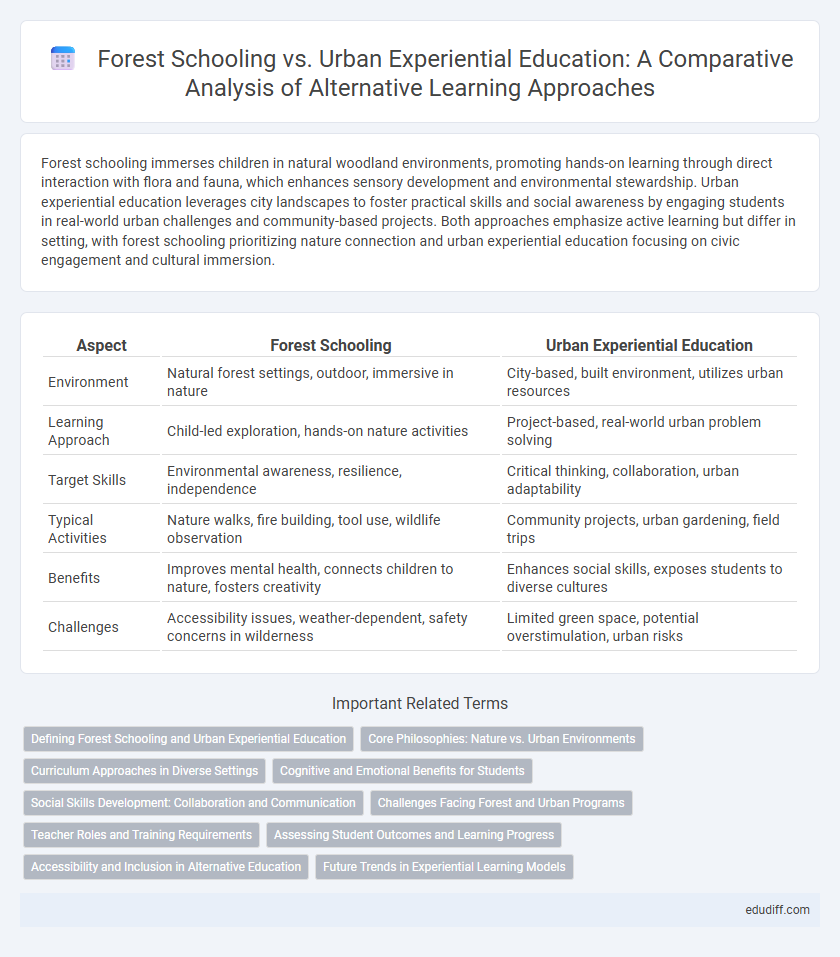Forest schooling immerses children in natural woodland environments, promoting hands-on learning through direct interaction with flora and fauna, which enhances sensory development and environmental stewardship. Urban experiential education leverages city landscapes to foster practical skills and social awareness by engaging students in real-world urban challenges and community-based projects. Both approaches emphasize active learning but differ in setting, with forest schooling prioritizing nature connection and urban experiential education focusing on civic engagement and cultural immersion.
Table of Comparison
| Aspect | Forest Schooling | Urban Experiential Education |
|---|---|---|
| Environment | Natural forest settings, outdoor, immersive in nature | City-based, built environment, utilizes urban resources |
| Learning Approach | Child-led exploration, hands-on nature activities | Project-based, real-world urban problem solving |
| Target Skills | Environmental awareness, resilience, independence | Critical thinking, collaboration, urban adaptability |
| Typical Activities | Nature walks, fire building, tool use, wildlife observation | Community projects, urban gardening, field trips |
| Benefits | Improves mental health, connects children to nature, fosters creativity | Enhances social skills, exposes students to diverse cultures |
| Challenges | Accessibility issues, weather-dependent, safety concerns in wilderness | Limited green space, potential overstimulation, urban risks |
Defining Forest Schooling and Urban Experiential Education
Forest Schooling is an outdoor educational approach emphasizing child-led exploration in natural woodland settings, fostering environmental awareness, resilience, and holistic development. Urban Experiential Education involves hands-on, real-world learning within city environments, utilizing urban spaces and communities to develop problem-solving skills and social engagement. Both methods prioritize experiential learning but differ fundamentally in context and environmental interaction.
Core Philosophies: Nature vs. Urban Environments
Forest schooling emphasizes immersive, hands-on learning in natural settings, fostering ecological literacy and emotional resilience through direct interaction with flora and fauna. Urban experiential education prioritizes dynamic city environments as rich, real-world classrooms that cultivate social awareness, creativity, and problem-solving skills within diverse cultural and infrastructural contexts. Both approaches champion experiential learning but diverge in their core philosophies by centering either the natural ecosystem or the urban landscape as the primary educational resource.
Curriculum Approaches in Diverse Settings
Forest Schooling emphasizes experiential, nature-based learning that fosters environmental stewardship and holistic development through unstructured, child-led activities in natural settings. Urban Experiential Education integrates interactive, community-centered projects within city landscapes, promoting social awareness and real-world problem solving tailored to diverse urban challenges. Both approaches adapt curricula to their unique environments, prioritizing hands-on learning and cultural relevance to enhance student engagement and skill acquisition.
Cognitive and Emotional Benefits for Students
Forest schooling enhances cognitive development by immersing students in natural environments that stimulate sensory engagement and problem-solving skills, leading to improved attention and memory retention. Urban experiential education fosters emotional resilience through diverse, real-world challenges and social interactions, promoting adaptability and emotional intelligence. Both approaches uniquely support holistic learning, with forest schooling emphasizing connection to nature and urban methods advancing practical life skills.
Social Skills Development: Collaboration and Communication
Forest schooling enhances social skills development by immersing children in natural settings that encourage teamwork and effective communication through cooperative tasks and problem-solving activities. Urban experiential education fosters collaboration by providing dynamic, real-world scenarios where students engage with diverse peers, enhancing adaptability and interpersonal skills. Both approaches cultivate essential social competencies, but forest schooling uniquely promotes empathy and environmental awareness alongside communication and collaboration.
Challenges Facing Forest and Urban Programs
Forest schooling faces challenges such as limited accessibility, seasonal weather constraints, and a lack of trained educators specializing in outdoor pedagogy. Urban experiential education struggles with issues including restricted green space, safety concerns, and the logistical difficulties of integrating natural elements into densely populated environments. Both programs require innovative solutions to address infrastructure limitations and ensure inclusive, engaging learning experiences.
Teacher Roles and Training Requirements
Forest schooling requires teachers to undergo specialized outdoor education training, emphasizing ecological literacy, risk management, and student-led exploration. Urban experiential education demands educators skilled in navigating diverse urban environments, integrating community resources, and fostering social engagement through hands-on activities. Both approaches prioritize adaptive teaching methods but differ in environmental focus and practical skill sets essential for effective instruction.
Assessing Student Outcomes and Learning Progress
Forest schooling enhances student outcomes by promoting emotional resilience, environmental stewardship, and hands-on problem-solving skills through immersive natural experiences. Urban experiential education fosters critical thinking, cultural awareness, and adaptability by engaging learners in diverse, real-world urban challenges and community-based projects. Comparative studies reveal that while forest schooling excels in enhancing ecological literacy and self-regulation, urban experiential education significantly improves social collaboration and civic engagement competencies.
Accessibility and Inclusion in Alternative Education
Forest schooling offers natural, sensory-rich environments promoting inclusivity by engaging diverse learning styles and abilities, often accommodating students with sensory processing differences or attention challenges. Urban experiential education enhances accessibility through structured, city-based resources and culturally relevant curricula, making alternative education reachable for marginalized communities. Both models prioritize adaptive pedagogies, yet urban programs typically provide easier physical access and integration with public services, while forest schools emphasize ecological connection and holistic development.
Future Trends in Experiential Learning Models
Forest schooling emphasizes immersive nature experiences fostering environmental stewardship and resilience, while urban experiential education integrates city landscapes to develop problem-solving and social skills. Future trends highlight hybrid models combining outdoor forest environments with urban contexts, leveraging technology to personalize learning and promote sustainability awareness. Adaptive experiential frameworks are expected to prioritize interdisciplinary curricula and inclusivity, preparing learners for complex ecological and societal challenges.
Forest Schooling vs Urban Experiential Education Infographic

 edudiff.com
edudiff.com